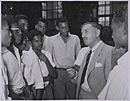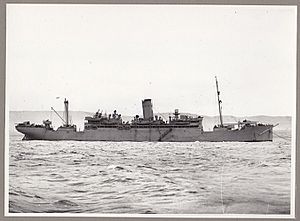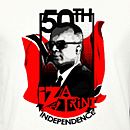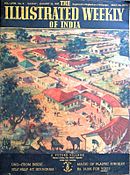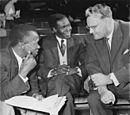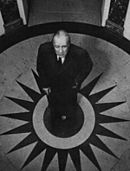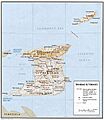V. S. Naipaul facts for kids
Quick facts for kids
Sir
V. S. Naipaul
FRAS TC
|
|
|---|---|
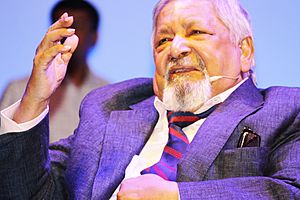
Naipaul in 2016
|
|
| Born | Vidiadhar Surajprasad Naipaul 17 August 1932 Chaguanas, Caroni County, Colony of Trinidad and Tobago |
| Died | 11 August 2018 (aged 85) London, England |
| Occupation |
|
| Nationality | British |
| Alma mater | University College, Oxford |
| Period | 1957–2010 |
| Genre |
|
| Notable works |
|
| Notable awards |
|
| Spouses |
Patricia Ann Hale
(m. 1955; died 1996)Nadira Khannum Alvi
(m. 1996) |
| Parents | Seepersad Naipaul (father) |
| Relatives |
|
Sir Vidiadhar Surajprasad Naipaul (born August 17, 1932 – died August 11, 2018) was a famous writer. He was born in Trinidad but became a British citizen. He wrote many books, both fiction (made-up stories) and nonfiction (true stories).
Naipaul was known for his funny early novels about life in Trinidad. Later, his books became more serious, exploring feelings of not belonging. He also wrote detailed accounts of his travels and observations. He published over thirty books during his fifty-year career.
His important novel, A House for Mr Biswas, came out in 1961. He won the Booker Prize in 1971 for In a Free State. He also received the Jerusalem Prize in 1983. Trinidad and Tobago gave him their highest honor, the Trinity Cross, in 1989. In 1990, he was made a knight in Britain, and in 2001, he won the Nobel Prize in Literature, one of the world's most important awards for writers.
A Writer's Journey
Early Life and Family
V. S. Naipaul was born on August 17, 1932, in Chaguanas, a town in Trinidad. Trinidad was a British colony at that time. He was the second child and first son of Droapatie and Seepersad Naipaul.
His father, Seepersad, worked as a journalist. He wrote stories for the Trinidad Guardian newspaper. Naipaul later said that his father's love for writing inspired him to become a writer too.
Naipaul's grandparents had moved to Trinidad from British India in the late 1800s. Many people from India came to British colonies like Trinidad to work on sugar plantations. This happened after slavery was ended, and these workers came under a system called indenture.
His family had a Hindu background. Over time, some of their traditions changed in Trinidad. For example, they started eating chicken and fish, and celebrated Christmas. The languages from India slowly disappeared, and Naipaul and his siblings were encouraged to speak only English.
When Naipaul was seven, and then permanently at age nine, his family moved to Port of Spain, the capital of Trinidad.
School Days and University
-
A 1790 aquatint of High Street, Oxford, showing University College in the left foreground. A century and half later, V. S. Naipaul would spend four years at the college.
Naipaul attended Queen's Royal College (QRC) in Port of Spain. It was a good school, similar to British public schools. Before he turned 17, he won a scholarship from the Trinidad government to study abroad. He chose to go to Oxford University in England to study English. He wanted to become a writer.
In August 1950, Naipaul traveled to London. He started taking notes about his journey right away, knowing he was on his way to becoming a writer. These notes later helped him write parts of his novel The Enigma of Arrival.
At Oxford, Naipaul found his writing attempts difficult. He felt lonely and sad. In 1952, he met Patricia Ann Hale, a history student. She became a close friend and helped him through this tough time. With her support, he slowly started writing again.
In 1953, Naipaul's father became ill and passed away. This was a very sad time for the family. Naipaul was in England and could not return for the funeral.
After graduating from Oxford in 1953, Naipaul found it hard to find a job in Britain. He continued to try writing while working odd jobs and borrowing money.
Starting His Writing Career in London
-
Pauline Henriques and Samuel Selvon reading a story on BBC's Caribbean Voices. In December 1954, Naipaul joined the staff.
-
The old Langham Hotel in a picture-postcard ca. 1903. Here, in 1955 in the BBC freelancers' room, Naipaul wrote the first story of Miguel Street.
In December 1954, Naipaul got a part-time job at the BBC (British Broadcasting Corporation). He became a presenter for a weekly radio show called Caribbean Voices. This show helped many Caribbean writers get their start. Naipaul worked there for four years.
In January 1955, Naipaul and Patricia Hale got married. They kept their wedding very simple. Patricia continued to support them financially while Naipaul focused on writing.
One afternoon in 1955, while working at the BBC, Naipaul wrote a short story. It was based on a neighbor he remembered from his childhood in Port of Spain. Other writers who read it encouraged him. Over the next five weeks, he wrote his first book, Miguel Street. It was a collection of stories about that street. Even though it wasn't published right away, publishers noticed his talent.
Early Novels About Trinidad
A publisher named André Deutsch liked Miguel Street but wanted Naipaul to write a novel. So, Naipaul quickly wrote The Mystic Masseur in late 1955. It was accepted for publication, and he received some money.
In 1956, Naipaul visited Trinidad for two months. He observed the changes happening there as the country prepared for independence. He gathered ideas for his next book, The Suffrage of Elvira, a funny novel about a rural election in Trinidad.
The Mystic Masseur was published in 1957 and received good reviews. Naipaul also got a full-time job for a short time, which helped him financially. He also started reviewing books for a magazine called New Statesman.
His early novels gained recognition. The Mystic Masseur won the John Llewellyn Rhys Prize in 1958. Miguel Street won the Somerset Maugham Award in 1961.
A House for Mr Biswas
Naipaul started writing A House for Mr Biswas not long after moving to a new flat with Pat. This book was a fictional story based on his father's life and Naipaul's childhood memories.
The main character, Mohun Biswas, tries many different jobs, like a sign painter and a reporter. He often depends on his wife's large family, the Tulsis, who are shown in a very humorous way. Mr Biswas wants to have his own home and be independent. The book shows his struggles and his witty personality. Eventually, he buys a house before he dies at age 46.
This book was very important to Naipaul. Critics loved it, calling it a masterpiece. It was seen as a clear picture of how colonialism affected people's lives. In 2011, Naipaul dedicated the book to his late wife, Patricia, who had passed away in 1996.
Travels and New Perspectives
-
Dr. Eric Williams, the Premier of Trinidad and Tobago, invited Naipaul to visit in early 1961 and to write a book on Caribbean history, published as The Middle Passage.
In 1961, Naipaul and Pat visited the Caribbean. The Premier of Trinidad and Tobago, Dr. Eric Williams, asked Naipaul to travel to other Caribbean countries and write a book about the region. This resulted in The Middle Passage: Impressions of Five Societies, his first travel book. In this book, Naipaul explored the history of the islands and how they were shaped by slavery and colonialism.
In 1962, Naipaul and Pat traveled to India for a year. It was Naipaul's first visit to the land where his ancestors came from. His book about this trip was called An Area of Darkness. He felt a mix of emotions in India, sometimes feeling overwhelmed by the poverty but also drawn to the people and places.
While in India, he also wrote a novel called Mr. Stone and the Knight's Companion and some short stories. Before leaving India, he was asked to write a monthly "Letter from London" for an Indian magazine, which he did for two years.
Exploring Identity and Politics
After his trip to India, Naipaul felt creatively tired. He struggled to find new ideas for his stories. His finances were also low.
He was then introduced to a new social circle in Britain, which helped him. He also received a loan that allowed him to buy a house in London.
In 1964, Naipaul wrote a story called "A Flag on the Island" for a movie, but the movie was never made. The story was set on a Caribbean island during a hurricane and explored how people tried to help each other.
Naipaul then started working on his novel The Mimic Men. He finished it while he was a Writer-in-Residence at Makerere University in Uganda, Africa. This novel was different from his earlier funny books. It explored serious themes about identity and politics in newly independent countries. The story is about a politician from a fictional Caribbean island who is in exile in London and writes his memories. The book received good reviews and made people think about the challenges faced by new nations.
History and African Experiences
-
At "Kenya Day," Leipzig, 1960, Milton Obote, centre, later PM of Uganda, demanded the release of Jomo Kenyatta, the Kenyan nationalist. In 1966 and 1967, Obote would depose all the Ugandan kings, including the Kabaka of Buganda.
In 1966, Naipaul was asked to write a book about Port of Spain. This project grew into The Loss of El Dorado, a historical book about Trinidad based on old documents. His wife, Pat, spent many months researching in libraries for this book. It explored the island's history, including the search for the mythical city of El Dorado and the impact of slavery.
After finishing this book, Naipaul and Pat traveled to Trinidad and Canada, looking for a new place to live. They eventually returned to Britain.
Naipaul had also traveled in Africa, visiting Kenya, Uganda, and Tanzania. These experiences inspired his next book, In a Free State, which won him the Booker Prize in 1971. The main story in the book is about two young Europeans driving across an African country. It explores themes about the end of the colonial era and the challenges faced by countries gaining independence.
Later Works and Themes
-
Naipaul met Argentine author Jorge Luis Borges in Buenos Aires in 1972. Here Borges is shown three years earlier.
-
Rochester with dying wife from Jane Eyre.jpg
Jane and Roche in Guerrillas also evoke the title character in Jane Eyre and her employer Rochester, whose deranged West Indian wife dies at the end of the novel while attempting to set fire to their house.
In 1974, Naipaul wrote the novel Guerrillas. This book was inspired by real events and explored social issues in the Caribbean.
His novel A Bend in the River, published in 1979, marked a new direction. In this book, he started exploring the history and traditions of different cultures, moving beyond just the "New World" (the Americas).
In 1987, he published The Enigma of Arrival, a novel with five sections.
Naipaul continued to write nonfiction books. In his 1998 book Beyond Belief: Islamic Excursions Among the Converted Peoples, he discussed how Islam has influenced different cultures. His last nonfiction book was The Masque of Africa: Glimpses of African Belief (2010), based on his trips to Africa. In this book, he explored local religious beliefs and rituals.
Personal Life
In 1995, Naipaul's wife, Patricia, became ill with cancer and passed away in 1996.
Two months after her death, Naipaul married Nadira Alvi, a journalist from Pakistan. He had met her in Lahore. In 2003, he adopted Nadira's daughter, Maleeha.
Naipaul's brother, Shiva Naipaul, was also a novelist and journalist. Shiva passed away in 1985 at the age of 40.
Passing Away
V. S. Naipaul died at his home in London on August 11, 2018. Before he passed away, he read and discussed a poem called Crossing the Bar by Lord Tennyson with his family. His funeral was held at Kensal Green Cemetery.
Awards and Honors
Naipaul received many important awards for his writing:
- Booker Prize for In a Free State (1971)
- Jerusalem Prize (1983)
- Trinity Cross (Trinidad and Tobago's highest honor) (1990)
- Knight Bachelor (made a knight by the British Queen) (1990)
- Nobel Prize in Literature (2001)
Works
Fiction Books
- The Mystic Masseur (1957)
- The Suffrage of Elvira (1958)
- Miguel Street (1959)
- A House for Mr Biswas (1961)
- Mr Stone and the Knights Companion (1963)
- The Mimic Men (1967)
- A Flag on the Island (1967)
- In a Free State (1971) – Won the Booker Prize
- Guerrillas (1975)
- A Bend in the River (1979)
- The Enigma of Arrival (1987)
- A Way in the World (1994)
- Half a Life (2001)
- Magic Seeds (2004)
Nonfiction Books
- The Middle Passage: Impressions of Five Societies (1962)
- An Area of Darkness (1964)
- The Loss of El Dorado (1969)
- The Overcrowded Barracoon and Other Articles (1972)
- India: A Wounded Civilization (1977)
- A Congo Diary (1980)
- The Return of Eva Perón and the Killings in Trinidad (1980)
- Among the Believers: An Islamic Journey (1981)
- Finding the Centre: Two Narratives (1984)
- A Turn in the South (1989)
- India: A Million Mutinies Now (1990)
- Beyond Belief: Islamic Excursions among the Converted Peoples (1998)
- Between Father and Son: Family Letters (1999)
- The Writer and the World: Essays (2002)
- A Writer's People: Ways of Looking and Feeling (2007)
- The Masque of Africa: Glimpses of African Belief (2010)
Images for kids
-
Indian women shopping in Port of Spain, Trinidad, 1945.
-
Chaguanas is near the Gulf of Paria coast.
See also
 In Spanish: V. S. Naipaul para niños
In Spanish: V. S. Naipaul para niños
- Capildeo family
- Caribbean literature
- Postcolonial literature
- List of British writers
- List of Indian writers


